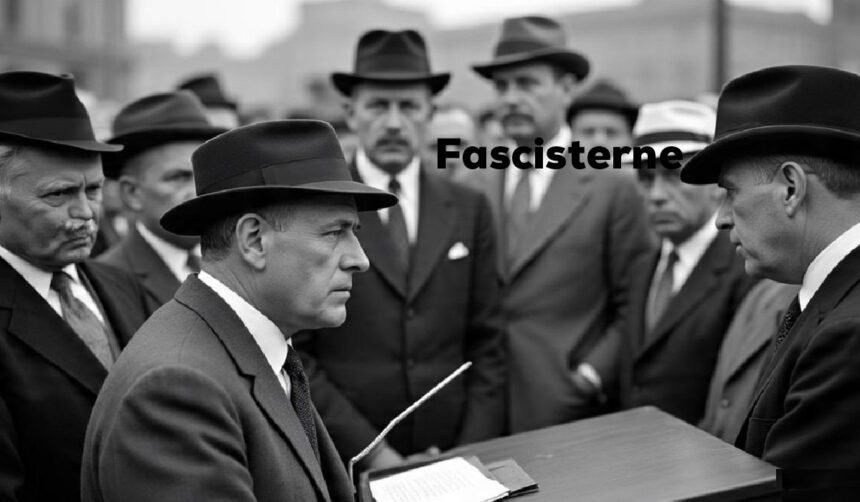Introduction to Fascisterne
The term fascisterne is the Danish plural for “fascist” and refers to individuals or groups that adhere to fascist ideologies marked by authoritarianism, extreme nationalism, and opposition to democratic principles. While the word has its deepest associations with the totalitarian regimes of the early to mid-20th century, it still holds relevance in modern political discourse, both as a historical reference and as a term used to warn about or criticize emerging authoritarian tendencies.
Fascisterne embodies a political philosophy where the state holds supreme power, dissent is suppressed, and national identity is often defined in exclusionary terms. Understanding the history and evolution of fascisterne is critical in a world where democratic values are continually tested, as it enables societies to identify and resist ideologies that threaten civil liberties and political freedom.
Etymology and Linguistic Roots
The origins of the word “fascist” lie in the Latin term fasces, a bundle of rods bound together, symbolizing strength through unity and authority. This imagery was later adopted by Benito Mussolini’s regime in Italy as a political emblem. In Danish, the plural “fascisterne” carries the same political weight but is closely tied to Denmark’s historical experience, especially during the Nazi occupation in World War II. While “fascist” in English and other languages can be used broadly or metaphorically in political rhetoric, in Danish political discourse, fascisterne often carries a sharper historical sting due to its direct association with collaboration, oppression, and betrayal during wartime. This linguistic specificity makes it not only a label but also a reminder of national experiences with authoritarianism.
Historical Context: The Birth of Fascism
The rise of fascisterne cannot be understood without looking back at the socio-political landscape of early 20th-century Europe. In the aftermath of World War I, countries like Italy and Germany faced severe economic collapse, political instability, and societal disillusionment. Benito Mussolini capitalized on these conditions, founding the National Fascist Party in 1921 and promoting a doctrine of national unity, strong centralized leadership, and militarism.
Across the border in Germany, Adolf Hitler’s Nazi Party rose to power with similar authoritarian principles, adding a central focus on racial purity and antisemitism that would culminate in the Holocaust. Beyond Italy and Germany, other countries such as Spain under Francisco Franco, Portugal under António Salazar, and several Eastern European nations saw the emergence of fascist movements, each adopting core ideological features while tailoring them to their own national contexts.
Fascisterne in Denmark and Scandinavia
In Denmark, the term fascisterne became particularly relevant during the German occupation from 1940 to 1945. The Danish Nazi Party, known as DNSAP (Danmarks Nationalsocialistiske Arbejderparti), modeled itself after Germany’s NSDAP and collaborated with the occupying forces. While they never gained mass popular support, their influence during the occupation included propaganda efforts, recruitment drives, and attempts to sway public opinion toward fascist ideology.
In Norway, Vidkun Quisling infamously led a collaborationist government, his name forever linked with treason. Sweden also had smaller fascist movements and sympathizers, though the country maintained official neutrality. After World War II, these groups and individuals faced public condemnation, legal consequences, and social ostracism, effectively erasing their influence from mainstream politics but leaving an indelible historical memory.
Core Ideological Beliefs of Fascisterne
Authoritarian Leadership
At the heart of fascisterne ideology lies the concentration of political power in the hands of a single leader, often portrayed as a national savior. This authoritarian structure eliminates checks and balances, silences opposition, and fosters a political environment where personal loyalty to the leader supersedes allegiance to democratic institutions.
Ultra-Nationalism
Fascisterne elevate the nation above all individual interests, defining identity in narrow cultural or ethnic terms. This exclusionary nationalism often leads to discrimination against minorities, immigrants, and dissenters, framing them as threats to national unity.
Militarism and Glorification of Violence
The ideology glorifies military strength and accepts violence as a legitimate tool for political change. Whether through aggressive foreign policy or internal suppression, fascisterne view conflict as necessary for maintaining strength and discipline.
Anti-Liberalism and Anti-Communism
Fascisterne reject liberal democratic values such as free speech, political pluralism, and civil liberties, framing them as weaknesses. They also strongly oppose socialism and communism, seeing them as ideological enemies that undermine national tradition and unity.
Corporatism and Controlled Economy
In economic terms, fascisterne often support a corporatist model where private enterprise exists but operates under heavy state direction. Labor unions are brought under state control, and industries are coordinated to serve national interests, frequently at the expense of worker rights and economic freedoms.
Methods and Tactics of Fascisterne
Fascisterne movements historically relied on sophisticated propaganda to shape public opinion and control narratives. State-run media, censorship, and the use of symbols, uniforms, and mass rallies created a sense of unity and power while intimidating opponents. Youth indoctrination through militarized organizations instilled loyalty from an early age, while political opposition was crushed through arrests, violence, or exile. The blending of cultural production—such as art and literature—with political messaging ensured that ideology permeated every layer of society.
Global Impact of Fascisterne Ideologies
Though originating in Europe, the influence of fascisterne-style ideologies spread globally. In Latin America, certain regimes adopted authoritarian nationalism and militarism reminiscent of European fascism. During the Cold War, far-right extremist networks persisted, sometimes finding covert support from anti-communist governments. Even in Asia, elements of ultranationalism and authoritarianism paralleled aspects of fascisterne ideology, showing its adaptability across cultures while retaining its core principles.
The Fall of Fascisterne After WWII
The defeat of the Axis powers in 1945 marked the collapse of fascisterne-led governments in Europe. Allied forces dismantled their political structures, banned fascist parties, and implemented democratic reforms. The Nuremberg Trials brought high-profile fascist leaders to justice, setting a precedent for international accountability in cases of war crimes and crimes against humanity. In Western culture, fascism became synonymous with oppression, brutality, and the negation of freedom, leading to its near-universal rejection in mainstream politics.
Neo-Fascism and Modern-Day Echoes
While classic fascisterne regimes are gone, neo-fascist movements have emerged, often repackaging old ideas under new labels. These modern groups exploit economic anxiety, immigration debates, and political polarization to gain traction. The internet and social media have become powerful tools for spreading extremist beliefs, recruiting members, and coordinating activities across borders. The challenge today lies in recognizing when nationalist rhetoric crosses into authoritarianism, as the line between patriotism and extremist ideology can sometimes blur.
Fascisterne in Danish Political Discourse Today
In Denmark, the term fascisterne is still used as a potent political label, often to warn against perceived authoritarian tendencies. However, its frequent use can also be controversial, with critics arguing that overuse dilutes its historical meaning. Contemporary debates sometimes feature accusations of fascism against far-right political movements, particularly those advocating strict immigration policies or challenging democratic norms. These debates highlight the continuing relevance—and sensitivity—of the term in Scandinavian politics.
Cultural Representations of Fascisterne
Danish films, literature, and documentaries frequently revisit the theme of collaboration and resistance during World War II, portraying fascisterne as antagonists in the national narrative. Museum exhibitions, such as those dedicated to the occupation years, educate the public about the dangers of authoritarianism. Satire and contemporary art also use fascist imagery to critique political trends, ensuring that cultural memory serves as a safeguard against the normalization of extremist ideologies.
Education and Public Awareness in Denmark
Denmark’s education system places significant emphasis on teaching the history of fascism and the Nazi occupation, ensuring that younger generations understand the fragility of democracy. Schools explore topics such as the Holocaust, resistance movements, and the role of fascisterne during the war. Public programs, community discussions, and annual remembrance events reinforce these lessons, promoting tolerance and civic responsibility.
Comparing Fascisterne Regimes vs. Democratic Societies
| Aspect | Fascist Regimes | Democratic Societies |
|---|---|---|
| Leadership | Dictatorial, centralized under one leader | Elected, accountable to the people |
| Civil Liberties | Severely restricted or eliminated | Protected by law and constitution |
| Political Opposition | Outlawed or violently suppressed | Encouraged and necessary for balance |
| Media Freedom | Controlled or censored by the state | Independent and free to criticize the government |
| Nationalism | Extreme, exclusionary | Moderate, based on civic identity |
Criticisms and Controversies
Fascisterne regimes have been universally criticized for human rights violations, including systemic racism, xenophobia, and antisemitism. Their rhetoric and policies often deepened social divisions, leading to violence, war, and genocide. Even in contemporary contexts, movements with fascisterne-like tendencies attract criticism for undermining democratic norms, spreading hate speech, and destabilizing political systems.
Lessons Learned from the History of Fascisterne
The history of fascisterne provides clear warning signs: the erosion of free speech, vilification of minorities, glorification of violence, and the centralization of power are all indicators of authoritarian drift. Protecting democratic institutions, maintaining a free press, and fostering political pluralism are essential safeguards. Societies must remain vigilant against propaganda, scapegoating, and the exploitation of economic or social crises for extremist political gain.
Conclusion
The legacy of fascisterne serves as both a historical record and a cautionary tale. From their rise in the chaos of post–World War I Europe to their eventual defeat and lingering ideological echoes, fascisterne exemplify the dangers posed by unchecked power, nationalism, and intolerance. Understanding their history is not simply an academic exercise—it is an essential step in preserving democratic values, promoting tolerance, and ensuring that the atrocities of the past are never repeated. In a world where political landscapes can shift rapidly, the lessons drawn from the era of fascisterne remain urgently relevant.
FAQs About Fascisterne
Q1: What does the word “fascisterne” mean?
A: Fascisterne is the Danish plural for “fascists.” It refers to people or groups who support fascist ideology, which is a far-right political system based on authoritarian leadership, extreme nationalism, and suppression of political opposition.
Q2: When did fascisterne first appear in history?
A: Fascisterne first appeared in the early 20th century, after World War I, when political and economic crises in Europe allowed authoritarian movements like Benito Mussolini’s in Italy and Adolf Hitler’s in Germany to gain power.
Q3: What are the main beliefs of fascisterne?
A: The main beliefs of fascisterne include strong centralized leadership, putting the nation above individual rights, rejecting liberal democracy, opposing communism, controlling the economy through the state, and using propaganda and force to maintain power.
Q4: Were there fascisterne in Denmark during World War II?
A: Yes. During Nazi Germany’s occupation of Denmark (1940–1945), the Danish Nazi Party (DNSAP) supported fascist ideas and collaborated with the occupiers, although they never gained widespread public support.
Q5: Is fascisterne ideology still relevant today?
A: While classic fascist regimes ended after World War II, similar far-right and authoritarian movements still exist today. These groups sometimes echo the language and ideas of historical fascisterne, making it important to understand the ideology and its dangers.
You May Read Also: Inomyalgia Relief: Powerful Guide to Understanding and Managing Muscle Pain
For More Information Visit Dotmagazine









